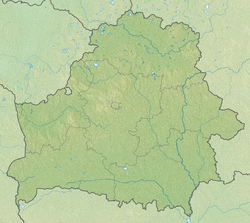Cold Synagogue, Minsk
| Cold Synagogue | |
|---|---|
Yiddish: די קאַלטע שול | |
 The former synagogue, in 1928 | |
| Religion | |
| Affiliation | Judaism (former) |
| Ecclesiastical or organisational status | |
| Status | Closed; subsequently destroyed |
| Location | |
| Location | Minsk, Minsk Region |
| Country | Belarus |
Location of the former synagogue in Belarus | |
| Geographic coordinates | 53°54′16″N 27°33′11″E / 53.90444°N 27.55306°E |
| Architecture | |
| Type | Synagogue architecture |
| Style | Romanesque |
| Completed |
|
| Destroyed | 1965 |
| Materials | Masonry |
The Cold Synagogue (Yiddish: די קאַלטע שול, Belarusian: Халодная сінагога) was a Jewish synagogue located on what is now Niamiha Street, in the center of Minsk, Belarus. It was not used as a place of study and therefore was not heated, which is why it received the name "Cold".[1] The masonry synagogue was considered the oldest in Minsk.[2]
History
[edit]The building was erected in 1570, though it is assumed that it housed an Orthodox church,[2][3] and only in 1796 the building was bought by the Jewish community, rebuilt and renovated. However, in architectural terms, this structure was originally characteristic of synagogues of that era.
The building was in the Romanesque style.[4]
In 1930, the synagogue was closed.[3]
In 1944, after the liberation of Minsk from the German occupation, the synagogue was again handed over to believing Jews for a short time.[3]
In 1965, the synagogue, although a protected monument, was demolished on the order of Petr Masherov, the leader of Soviet Byelorussia.[5] The destruction occurred as part of the reconstruction of this district of Minsk.[3][2] The destruction was attributable both to state antisemitism in Soviet Union as well as a more general disregard by Soviet authorities in 1950s and 1960s for historic preservation:[5] much of Old Town Minsk was destroyed in the 1960s reconstruction of Minsk in a socialist urban style.[4] The old synagogue building was next to the planned site for the Belarusian State Institute for Industrial Design.[4]
Gallery
[edit]- Schemes of the building
-
Cross-section, 1881
-
Detailed plans, 1881
-
Ground floor plan, made in 1954 during the reconstruction
- Photos
-
Photo made between 1901-1918
-
Aerial photo of the district with the synagogue at its center, 1941
-
The synagogue near the newly built Institute, 1960s
See also
[edit]References
[edit]- ^ "CИНАГОГИ В МИНСКЕ". Виртуальный штетл. Archived from the original on 9 February 2017.
- ^ a b c "ГІСТРЫЧНАЯ ЗАБУДОВА XVI-XIX СТАГОДДЗЯЎ ВУЛІЦА ШКОЛЬНАЯ І ШКОЛЬНЫ ДВОР". spadchina.by.
- ^ a b c d "Синагоги". minsk-old-new.com. Минск старый и новый. Retrieved 24 June 2021.
- ^ a b c Natallia Linitskaya, "Society and Space in (Post-)Socialist Cities: Directions in Research" in Materializing Identities in Socialist and Post-socialist Cities (eds Jaroslav Ira & Jiří Janáč: Karolinum Press, 2017), p. 54.
- ^ a b Vladimir Levin, "Jewish Cultural Heritage in the USSR and after Its Collapse" in Becoming Post-Communist: Jews and the New Political Cultures of Russia and Eastern Europe (ed. Eli Lederhendler: Oxford University Press, 2023), p. 97.
External links
[edit]- About the synagogue and the neighbouring district, with photos (in Belarusian)
- 1570 establishments in Belarus
- 1965 disestablishments in Belarus
- 16th-century synagogues in Europe
- 20th-century attacks on Jewish institutions
- Antisemitism in the Soviet Union
- Buildings and structures demolished in 1965
- Buildings and structures in Minsk
- Churches completed in 1570
- Demolished buildings and structures in Belarus
- Former churches in Belarus
- Former synagogues in Belarus
- Romanesque architecture in Belarus
- Romanesque and Gothic synagogues
- Synagogues completed in 1796







